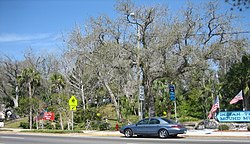Indian Temple Mound and Museum
|
Fort Walton Mound
|
|

Fort Walton Mound, in the Indian Temple Mound and Museum
|
|
| Location | Fort Walton Beach, Florida, USA |
|---|---|
| Coordinates | 30°24′15.948″N 86°36′26.352″W / 30.40443000°N 86.60732000°WCoordinates: 30°24′15.948″N 86°36′26.352″W / 30.40443000°N 86.60732000°W |
| NRHP Reference # | 66000268 |
| Significant dates | |
| Added to NRHP | October 15, 1966 |
| Designated NHL | July 19, 1964 |
The Fort Walton Mound (8OK6) is an archaeological site located in present-day Fort Walton Beach, Florida, United States. The large platform mound was built about 850 CE by the Pensacola culture, a local form of the Mississippian culture. Because of its significance, the mound was designated a National Historic Landmark in 1964.
Still reduced by time, the massive mound is still 12 feet (3.7 m) high and 223 feet (68 m) wide at the base. It was an expression of a complex culture, built by a hierarchical society whose leaders planned and organized the labor of many workers for such construction. The mound served combined ceremonial, political and religious purposes. At the center of the village and its supporting agricultural lands, the mound served as the platform for the temple and residence of the chief. Successive leaders were buried in the mound and additional layers were added over time.
This is one of three surviving mound complexes in the panhandle, the others being Letchworth Mounds and Lake Jackson Mounds state parks.
The Fort Walton Mound was probably built around 800 CE, although Charles H. Fairbanks who excavated the mound in 1960 believed it was built between 1500 and 1650 based on pottery sherds he uncovered and analyzed. The mound served as the ceremonial and political center of their chiefdom and probably the residence of the chief. It was also the burial ground of the elites in the society. Archaeological evidence suggests that several buildings once stood on top of the mound, perhaps at different times throughout its use. These buildings were probably done in the typical wattle and daub construction common among Southeastern Native American groups. By sometime in the late 1600s the mound was abandoned by its original builders and lay dormant in use until the area was reinhabited by white settlers in the mid 19th century.
...
Wikipedia


